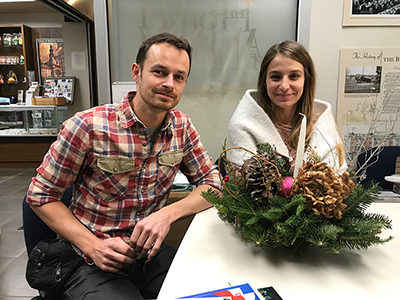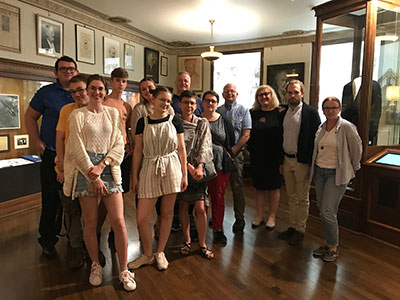dookolafiata.pl visited PMA
Asia and Pawel Poterski who have been traveling around the world since November 2018 in a Fiat 125p visited PMA today – Thank you – dookolafiata.pl!
Open House Chicago 2019
The PMA and PRCUA in the Open House Chicago was toured by 352 visitors on Saturday October 19, 2019.
Poles in Chicago Project International Exchange
Poles in Chicago Project International Exchange participants visited PMA today
Ze zbiorów Polskiego Muzeum w Ameryce w Chicago
Aktywna współpraca między Ministerstwem Kultury i Dziedzictwa Narodowego a Fundacją „Świątynia Sztuki” i pracownią konserwatorską „Ars Veta”, działającymi przy Muzeum Piśmiennictwa i Drukarstwa w Grębocinie, to przedsięwzięcia, które skupiają się przede wszystkim na zabezpieczeniu i ratowaniu dziedzictwa narodowego pozostającego poza granicami kraju, w tym zagrożonych zbiorów instytucji emigracyjnych.
Plakat polski ze zbiorów Muzeum Polskiego w Ameryce i Misji Polskiej w Orchard Lake
Wystawa „Plakat polski ze zbiorów Muzeum Polskiego w Ameryce i Misji Polskiej w Orchard Lake” dzięki współpracy z Muzeum Piśmiennictwa i Drukarstwa w Grębocinie będzie prezentowana w Muzeum Narodowym w Szczecinie od 10 marca do 28 maja 2017 roku.Jest to wybór około stu prac (plakatów, druków okazjonalnych i ilustracji) stanowiących
Painting the imaginations
Dolphins have a streamlined fusiform body, adapted for fast swimming. The tail fin, called the fluke, is used for propulsion while the pectoral fins, together with the entire tail section, provide directional control. The dorsal fin, in those species that have one, provides stability while swimming. Though varying by species,
Potter working a piece of clay
Dolphins have a streamlined fusiform body, adapted for fast swimming. The tail fin, called the fluke, is used for propulsion while the pectoral fins, together with the entire tail section, provide directional control. The dorsal fin, in those species that have one, provides stability while swimming. Though varying by species,
Painting the imaginations
Dolphins have a streamlined fusiform body, adapted for fast swimming. The tail fin, called the fluke, is used for propulsion while the pectoral fins, together with the entire tail section, provide directional control. The dorsal fin, in those species that have one, provides stability while swimming. Though varying by species,











Recent Comments